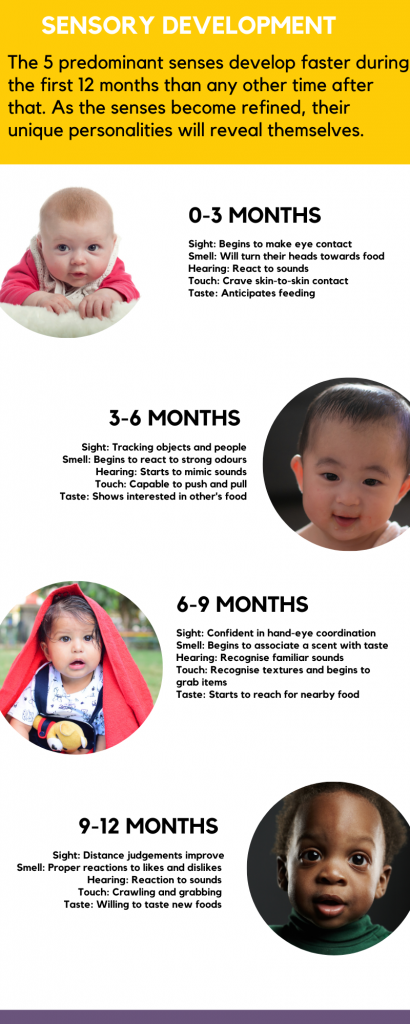From birth until early childhood, children explore and learn about the world by using all of their senses. Sensory play is a crucial part in the early childhood development as it allows children to retain information by engaging their senses. Numerous memories that adults have are associated with one or more senses.
Research shows that babies will learn about their environment by interacting with it rather than passive observation. Additionally, the experiences they gain are proven to be calming and therapeutic as it allows them to work through emotions and frustrations.
Providing babies and toddlers with opportunities to actively use all of their senses throughout the day will lead to better ability of the child to complete complex tasks. As we are big on sensory play at MTO, we encourage better language development, social interaction, and problem-solving skills.
What is sensory play?
All of the activities that are designed for sensory play will stimulate the children’s five senses. Inevitably, children are natural scientists, they enjoy touching, tasting, and experimenting in the environment that they find themselves. When they’re outside, you will notice them picking up sticks, leaves, and rocks. Our nursery will provide the means and materials needed but we encourage self-regulated actions from the children.
In every room, there are numerous sensory materials that improves the children’s sense of touch. Such activities will lay the foundation for developing other skills such as identifying objects and using their gross motor skills. At home, you can help the child to refine the skills by providing them activities such as splashing, moulding, and scooping.
Furthermore, our practitioners also motivate children to share the toys and materials available. As they become more confident in using their verbal skill, they will begin to discuss the differences between the objects they touch, hear, see, and taste. Also, they will begin to share their discoveries with peers and therefore build relationships.
To ensure that all of the children benefit from effective sensory experiences, we have treasure baskets and messy play trays in the baby room and for the older children there are tables and chairs around the room so that the children can sit at the table and explore playdough, crafts, and painting.
How to help your child at home
It’s important to mention that sensory play isn’t just about picking up stuff and feeling the texture. Realistically, such play is limited only by our imagination. At home, you can try the following:
- Babies – Use soap and water to create bubbles. Ensure that the baby is watching the bubbles float and allow them to land on its skin. Moreover, you can also scrunch some coloured paper near them and let them hear the noise, feel the contours of the paper and see the changes in shapes.
- Toddlers – Use a torch light to create different shadows and light on different objects that don’t have similar sizes and shapes. Also, you can let the child to mix paint colours and create forms and textures with fingers and sponges.
- Pre-schoolers – Let the child to play with kinetic sand and musical instruments. In addition, you can join in the pretend-play and interactive story telling.
Don’t forget that the most stimulating environment for children is the outdoors as they are surrounded by colours, textures, smells, and sounds.

The importance of sensory play
It’s essential to allow children to take part in sensory activities as it helps to create nerve connections in the brain’s pathways so that they can figure out for themselves what is important to learn and what to filter out. For instance, some children in early childhood will find it difficult to play with other children if there’s too much noise around them. Proper sensory play will teach the child to learn to block out the distraction and focus on what’s important at that time.
Another example is the fussy-eater that refuses to touch new textures. Sensory play in an environment with little expectations will help the child to discover and explore by touching and smelling. As the child is understanding the texture, a new positive connection will be built in the brain’s pathway. Hence, the child will be willing to at least try to taste new textures in foods.
What we do at MTO to include sensory play
In our Discoverers room we have treasure baskets, toys of different shapes and sizes, and materials from different textures. Furthermore, we also have a tray for messy and water play. All of our children enjoy making sensory experiences for themselves by painting and using paste to create their own shapes and textures. Babies are allowed to move freely around the rooms and discover their surroundings.
Additionally, in our Explorer room, there’s a chalk board, tray for messy play, tables for painting, and throughout the area there are spaces specifically designed for pretend play. Our practitioners initiate activities and engage in open conversations with the children. The discussions have essence to them so that the toddlers can learn and play at the same time.
Finally, in our Inventors room, our pre-schoolers have an open space to explore as much as they desire. Each area has a specific purpose so that it fits their age-appropriate needs that will help them to get ready for the next phase in their educational journey. The environment enables them to use media and technology, express themselves through music, art, and drama.
Conclusion
All of our activities for sensory play will help the children to learn and play at the same time – notably children of all abilities and backgrounds – show interest and engage with our practitioners throughout the day. The materials available appeal to children of all ages. Every day, we encourage children to experiment with the five predominant senses as we believe that it will help them to become responsible long-life learners.